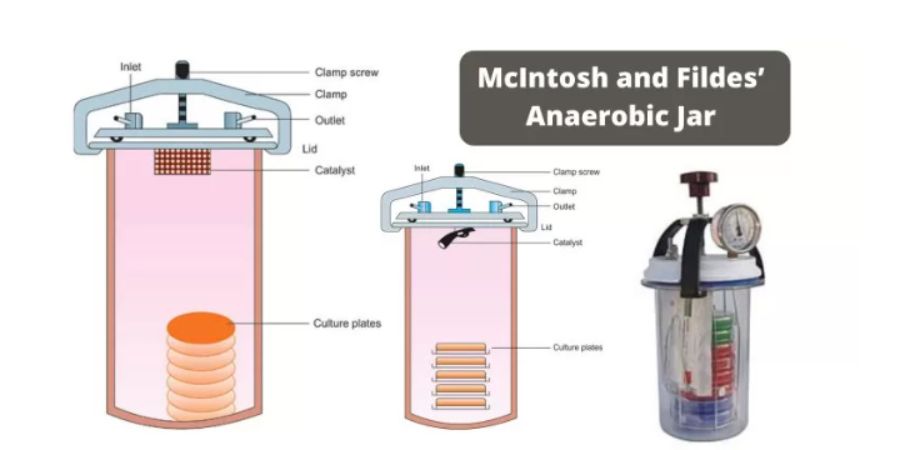

Today my vlog is anarobic jar
McIntosh fildes jar
The McIntosh jar is specially designed for the anaerobic culture which employs chemical method to create anaerobiosis inside the jar.It is either made of metal or glass with a metal lid that can be clamped airtight.The lid has two tubes for gas inlet and gas outlet and has electrical terminal for current supply.A small grooved porcelain spool, wrapped with a layer of palladinized asbestos is placed under the lid.
The culture plates are placed inside the jar and closed airtight with the lid.A vacuum pump is connected to the outlet gas tube and the vacuum is created inside the jar.After closing the outlet tap,the inlet tube is connected to the hydrogen supply.The palladinized Asbestos is heated by passing current supply.The heated palladinized asbestos act as the catalyst for the combination of residual oxygen with hydrogen to form water.Methylene blue is used as the indicator to check the anaerobiosis.Under anaerobic conditions the methylene blue will become colourless and become Blue when exposed to oxygen.
Gaspak
Gaspak is a commercially available disposable packet containing pellets of sodium borohydride and cobalt chloride with citric acid and sodium bicarbonate.After the culture plates are kept in the McIntosh fildes jar the packet is opened and added with water.It is immediately placed inside the jar and closed airtight.The reaction produces hydrogen that combines with oxygen to form water in the presence of palladinized Asbestos kept under the lid of the jar.The gaspak avoid the production of vacuum and addition of hydrogen jar and thus makes the procedure simple.
Reduction of medium
The culture media can be added with the reducing agent to create anaerobiosis of the medium.The agent that are commonly used are glucose, ascorbic acid or thioglycollate.
Identification of microorganisms
Introduction
The laboratory identification of bacteria in clinical specimens involves many steps
Collection of specimen
Transport of specimen to laboratory
Identification of organisms
Antibiotics susceptibility test
Collection and transport of specimen
According to the type of infection,the following specimen are collected
Sputum, urine, blood, cerebrospinal fluid, faeces,swab, throats, wound, conjunctiva,etc.pus.
Steps should be followed while collecting specimen
Specimen should be obtained as early as possible preferably prior to antimicrobial treatment.
Avoid contamination while collecting specimen
Take a sufficient quantity of material
Follow the appropriate universal precautions for safety thank you




